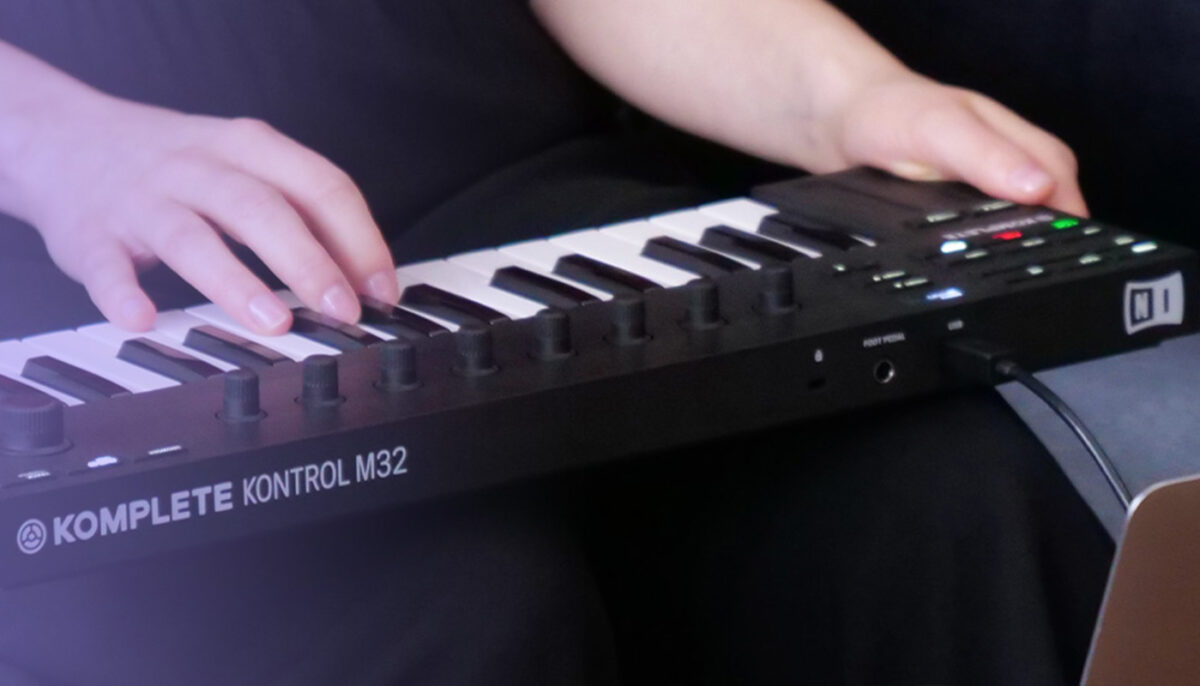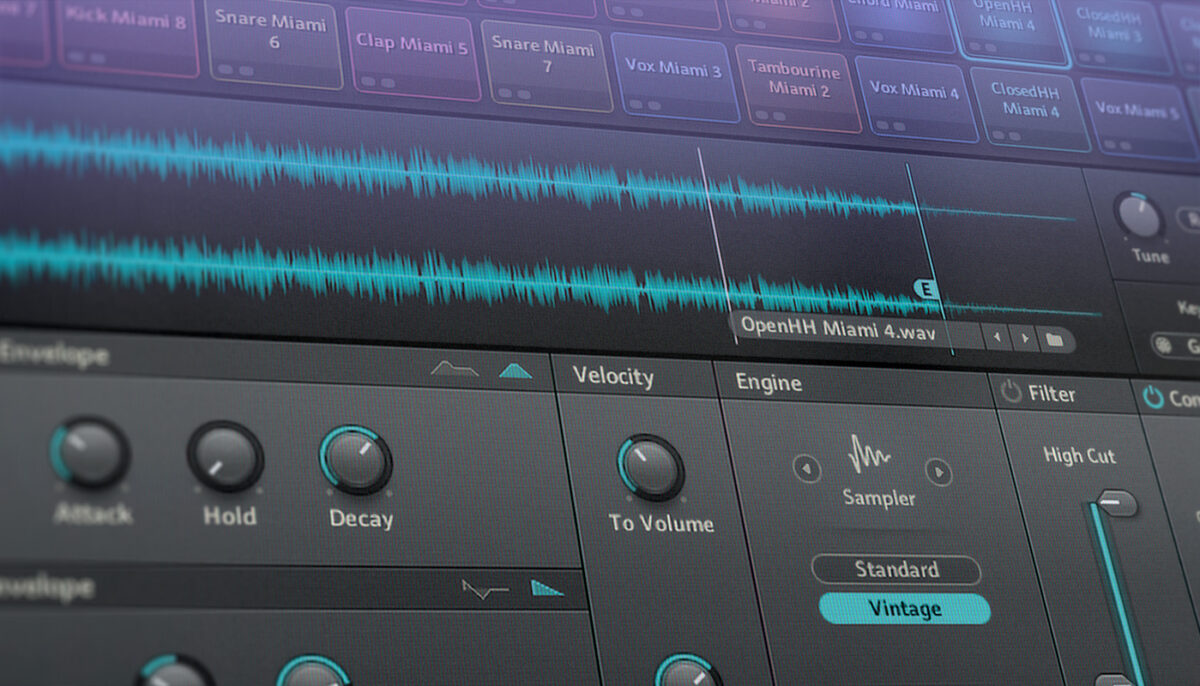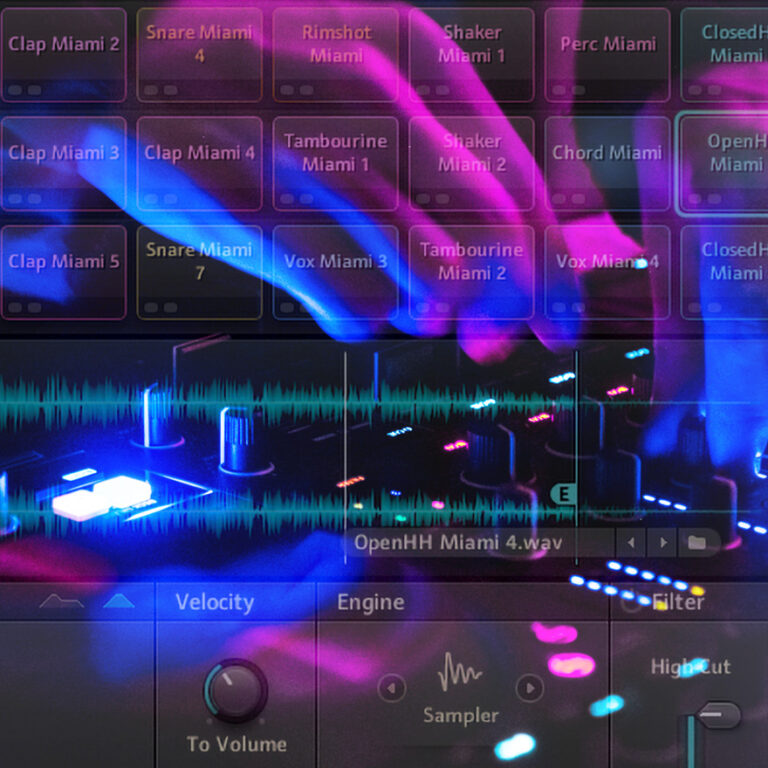Electronic music production is one of the fastest growing music genres and production methods today. With thousands of digital instruments, electronic synthesizers, and more at your fingertips, making electronic music that resonates with listeners can be easy and intuitive. In this guide, we will take you through the process of how to make electronic music. Let’s get started!

What is electronic music?
Electronic music is a genre of music that is made using electronic tools, computers, or synthesized sounds. This differs from traditional, acoustic musical instruments, where sound is produced by the physical vibration of the instrument itself (strings, percussion) or air passing through it (wind, brass).
Analog synthesizers and electric organs generate sounds from electrical voltages and circuits—these signals are converted into sound via an amplifier.
Digital instruments rely on more recent technology, replicating the behavior of analog synthesis in binary code. Today’s electronic music makes heavy use of computer software, offering unprecedented scope and flexibility for building and manipulating sounds digitally.
Electronic music evolved through the second half of the 20th century and it continues to grow, diversify, and gain popularity. New technology, production techniques, and subgenres are constantly being developed, making electronic music incredibly dynamic and progressive.
From disco and synth-pop to EDM and hip-hop, electronic music genres are rooted in underground scenes but are increasingly dominant in the mainstream, commercial music industry.
Electronic music can be composed entirely using electronic instruments, or a combination of both electronic and acoustic elements—for example, integrating synthesizers into a live band line-up, or sampling real-world sounds in a digital composition.
Software and tools for making electronic music
Whether you’re making electronic music at home or in a studio you’ll need a specific set of tools other than a computer.
Let’s explore a basic list of software and equipment you’ll need to produce electronic music.
1. DAW
A Digital Audio Workstation is the primary software for making electronic music. DAWs pack the full power of a studio into your computer, with the ability to record, edit, and mix large, multi-track projects. A DAW acts as a central hub for your entire set-up, capable of processing audio recordings alongside virtual instruments and external hardware. Most producers favor DAWs for their versatility and all-in-one connectivity.
1. MIDI Controller
MIDI controllers provide a hardware interface for controlling and playing other devices, including virtual instruments. They come in all shapes and sizes—the most popular are piano keyboards, ideal for playing melodies with sensitive dynamics, or drum pads, which are more suitable for tapping in beats and rhythms or triggering samples.
A MIDI controller is useful for producing electronic music as it combines the physicality of a hardware instrument with a practically infinite selection of software sounds and effects—a great way to expand your workflow and creative possibilities without breaking the bank.
MASCHINE by Native Instruments can be a MIDI controller. MASCHINE lets you produce beats, melodies, and harmonies with cutting edge software and hardware.
3. Sound libraries
Samples and loops are the building blocks of electronic music. You can create your own from scratch, or take advantage of a wide range of genre-specific Expansions to save time or help you get started creating beats and projects as a beginner.
Kontakt is Native Instruments’ flagship sampler. As well as drum hits and synth sounds, its vast library also includes high-quality recordings of real instruments. You can even emulate the nuanced dynamics of a full symphony orchestra—virtually indistinguishable from the real thing.
4. Plugins
Plugins are software audio units that run inside your DAW environment, giving you the choice to add new sounds and features. Plugins can be divided into two main categories: instruments and effects.
Some virtual instruments are simulations of existing hardware, while others capitalize on the power of computers with an intricacy that is only possible in software form. Soft synths tend to pack in more features at a lower price point, so you can build up your own toolkit for making digital music without the sacrifices in cost or space.
Effects plugins manipulate an input audio signal in myriad ways. Creative effects include distortion, filtering and EQ, delay and reverb, and modulation such as tremolo, chorus, flanger and phaser. More subtle effects are applied later in the production process for cleaning up or correcting a mix.
If you’re interested in trying out some plugins, you can download Komplete Start with over 2,000 studio-quality sounds. It comes with everything you need to make electronic music: 16 pro-grade synths and sampled instruments, plus effects, loops, and samples.
5. Audio interface
An audio interface is a bridge between software and hardware, featuring numerous inputs for instruments and microphones and outputs for speakers and headphones.
Connect an audio interface to your computer via USB to ensure the highest audio recording quality. Many interfaces also feature MIDI inputs and outputs, making them an essential bit of kit for connecting up different devices in your studio workflow.
6. Speakers or headphones
Along with all of the above, you will need a decent pair of headphones or speakers to listen to your electronic tracks. Check out iZotope’s guide on headphones and speakers to decide which is best for your production setup.

How to make electronic music
1. Choose your subgenre
‘Electronic music’ is an umbrella term for a web of interconnected genres and styles. Before creating your music, take some time to listen to the different subgenres of electronic music to determine which kind of style you would like to create. While this is by no means a complete list, we have guides for a few different genres below for you to choose from:
Also take some time to explore the different kinds of EDM and electronic software that’s available to help you get the sound you’re looking for.
2. Determine the tempo
Many subgenres of electronic music feature prominent drums as a core element, so they can be distinguished by their tempo (measured in beats per minute, or BPM).
Techno and trance music is built around a loud, pulsing 4/4 kick drum at approximately 140 BPM—this supposedly matches the body’s elevated heart rate when dancing energetically in a nightclub. Electro runs at a similar tempo but has more of a glitchy, off-kilter vibe with broken beats.
Disco and house music use the same regular ‘four-to-the-floor’ kick pattern at a lower tempo, usually between 120 and 130 BPM. More space between each beat allows for more swing and soulful feeling in the percussion grooves. UK garage runs at the faster end of this range, while genres like hardcore and gabber push the 4/4 beat all the way up beyond 160 BPM for an intense, frenetic energy.
Jungle and drum & bass use similarly high tempos (usually around 170 BPM) but we tend to perceive the beat in half-time due to how the rhythms are sequenced. The same concept applies to dubstep—tracks tend to be around 140 BPM, but the half-time feel is what gives them that signature swaying energy, with lots of space between the kicks and snares.
Hip-hop beats are usually somewhere in the range of 70 to 100 BPM—it depends whether you want an energetic, uplifting vibe or something more loose and laid-back. Trap and drill tracks tend to sound a bit faster, often incorporating double-time rhythms in their trademark rat-a-tat hi-hats.
Some electronic genres like new wave and synth-pop include songs at a wide range of tempos. Others, like ambient, experimental, and IDM, are less defined by regimented beats, sometimes not centered around a beat at all.
3. Write your drum beat
Many electronic genres originally emerged around nightclubs and dancing. Because of these roots, it’s very common to produce electronic music beginning with the beat before adding chords and melodic elements.
A solid drum beat acts as a foundation and establishes the overall energy of a track. Whatever the style, there are some key components that make up a beat: kick, snare or clap, hi-hats and cymbals, toms and other pitched drums.
How you sequence and arrange beats will depend on the subgenre you want to write, so listen closely to reference tracks to get a feel for how the rhythms move and elements complement each other to create the overall sound.
A purpose drum sampler such as BATTERY makes it easy to audition and compare samples, mix and process each channel individually, and map kits to be triggered via MIDI.
It’s also beneficial to learn how to make electronic music using samples and breaks. The practice of lifting and flipping snippets from existing records is a long tradition in dance and hip-hop music. Breakbeats add color, texture, and swing where electronic beats can otherwise risk sounding rigid and static.
Here’s what a basic house drum beat can sound like.
4. Create a bass line
Bass works both as melody and percussion in electronic music, so it’s essential to lock in the interplay between bass line and drum beat.
The low-end frequencies are felt through the entire body, and lots of electronic music is driven by bass—indeed, dance music arrangements are often stripped back to only drums and bass.
Bass takes many forms, and it can be as simple or elaborate as you like—from the melodic runs of a sampled or live bass guitar, to percussive donks and sub bass rumbles. The bass can reinforce the hits of the beat, or be syncopated against it to create more rhythmic contrast, emphasizing the off-beats.
Below, listen to what a house bass line can sound like.
Learn more about writing bass lines in this in-depth tutorial.
5. Choose your chords
Chords are what tug at the heartstrings and carry the emotion in a piece of music. Most popular songs follow familiar, somewhat formulaic chord patterns, playing on our expectations of what will come next based on what we’ve heard in music before.
Electronic music is no exception to this. Dance music is typically reduced to a few chords in repetitive loops, used almost as percussion more than melody—within this minimalist framework, any shifts in the chords are extra impactful.
More experimental music takes turns we weren’t expecting, or even defies our ability to make predictions at all. In a way, the secret sauce of making powerful music is a certain balance of the familiar and the unfamiliar, the expected and the unexpected.
Instinct and feeling play an important role in writing chords, but there is also technical theory behind what ‘works’, with history and conventions that have been established over the course of centuries. Getting to grips with the basics of music theory will really help you gain control of chords and note intervals in your own songwriting and producing.
Another tool that can help generate chord progressions for electronic production is PLAYBOX, a Native Instruments Play Series instrument that combines chord generation with sample layering and effects.
6. Write a melody
In many styles of pop and electronic music, the melody is a topline hook—the center of attention, the most memorable element, the bit that gets stuck in your head.
Melody is closely tied to what the chords and bass are doing in your track, following the same rules of harmony and music theory. Certain notes in the melody will complement a chord, while others might clash and create tension—of course, this can be intentional!
The magic of writing a great melody is not something that’s easy to teach. Sometimes a songwriter just knows when it sounds right, without being able to rationalize why or explain in terms of music theory. A lot of it comes down to perseverance and training your ear through years of experience.
For more info and analysis, read our guide to writing melodies.
7. Create transitions effects
Transitions are important as they create flow between sections and energy levels in a track, giving the composition an overall sense of cohesion and unity.
Drum fills are often used to mark the end of a four, eight, or sixteen-bar phrase. These can be as simple as a quick snare or tom fill, or adding a cymbal crash. A common trick in dance music is an extended snare roll, which builds progressively from quarter notes, to 8th notes, to 16th, and so on, growing in intensity with each step.
White noise swells and tonal risers are used in a similar way to build up to a big drop in EDM music, a genre where the dynamics are quite upfront and in-your-face. Another helpful tool for controlling impact is a high-pass filter—cutting out the bass, then slamming it back in.
A well-placed moment of silence can be effective as a transition too. We often hear this in dance tracks at the top of a build up, right before the drop. While the above examples are rather maximal, it’s worth keeping in mind that less is more sometimes. Removing elements can concentrate the listener’s focus and be just as powerful as adding more.
To learn more about creating transitions in your electronic music production, check out iZotope’s blog on EDM tips.
8. Add vocal and instrument effects
Effects are used in electronic music to blend elements together and augment sounds, creating a sense of expansive space. Heavier use of effects can produce more exciting and extreme effects, warping and manipulating the source audio beyond all recognition.
Applying effects to vocal or instrument channels creates variation, so we don’t just hear identical loops on repeat. This in turn adds intrigue and keeps things sounding fresh and exciting for the listener.
In this video from the Sketches series, Calum from Clouds runs through his process for sound design, layering up patches then processing them with effects in intuitive ways. He uses delay plugins a lot to create morphing, rhythmic loops that he calls “instant techno”. Distortion and noise help to boost the presets and create a huge soundscape with a lot of depth.
9. Mix and master
Mixing and mastering are the final stages in the process, known collectively as ‘post-production’. This is where recordings are tweaked, balanced, and polished to create the final version of a track.
While post-production was traditionally a separate job to the music creation itself, producers and artists are increasingly taking control of the entire process. Mixing is essential in how to make electronic music sound punchy and professional—the best practice is to get the balance right at the time of recording, rather than having to make corrections retroactively.
For professional releases, it’s still common to hand over the mastering duties to specialist engineers. That said, learning the basics of mastering a beat will deepen your understanding of music production and certainly improve the quality of your work overall.

Electronic music song structure
There are no hard and fast rules to song arrangement, but many music styles and genres follow similar, familiar song structures.
For the best part of a century, the standard verse-chorus song structure dominated the popular music charts. In recent years, however, commercial hits are increasingly influenced by the sounds and arrangements of dance records from the underground electronic music scenes.
Dance music is functional, specifically structured for DJs mixing sets in clubs. This puts more focus on repeating sections and motifs, and less need for variation within a track, as building up a mosaic of different sounds and energy levels is the role of the DJ.
That said, a lot of electronic music still follows the traditional pop song structure. We’ll break down the main sections of a song below as a general guide, but feel free to deviate from this. Listen to your project and try to feel when a section feels rushed, or when it drags and starts to feel boring, and lay out the arrangement of your track however it feels best to you.
1. Intro
The intro is the initial lead-in to a piece of music, where the style, tempo, and instrumentation are established.
As the first thing you hear, nailing a strong intro is really important. This is how you grab the listener’s attention—the intro is a statement of intent, a chance to make an initial impact and set the scene for what follows musically.
Some song intros use the same chords or hook as the verse or chorus sections, but in other cases the intro is a unique part, distinct from the main song and occurring only once.
The intros of dance tracks usually feature a few isolated elements, with more layers introduced later. It often starts with a drum beat, making it easy to blend multiple tracks together in a DJ set.
2. Verse
Verses traditionally contain the forward momentum that gives a song its linear structure from beginning to end. In vocal music with lyrics, the verses are where the main storytelling substance is found.
A lot of electronic music is instrumental, but this doesn’t mean you can’t develop a narrative using melodic lines. By this point in a track, the beat will be rolling and most elements of the instrumentation will be present.
As in popular music as a whole, many genres of electronic music are arranged into blocks of four, eight, or sixteen-bar phrases. Verse sections of consistent length give the overall piece a sense of predictability and balance that is familiar and pleasing to the ear.
3. Riser/build
Build-up sections are very common in techno and EDM music. These genres are all about tension and release—the build serves as a transition, building up pressure and intensity before the satisfying explosion of the chorus or drop.
The same is true in traditional pop songwriting, where this section is often called a pre-chorus. It is a short interlude that may work as a pivot between the chord patterns of the verse and the chorus. Here’s what a riser can sound like.
4. Chorus/drop
The chorus is the peak of the track, where the energy and instrumentation are at their most maximal. The chorus features the song’s main message and musical motifs.
It is common to write this section first when producing electronic music, as it is generally the fullest and most complex—once the big drop is locked in, you can create the rest of the arrangement simply by subtracting elements.
A key characteristic of the chorus is that it repeats. If you’re writing a song with a vocal part, the chorus typically features the same lyrics each time. That said, it’s a good idea to add variations to keep the track moving forward—repeating an identical drop won’t have as much impact as introducing a fresh twist the second time around.
5. Solo
A solo is an instrumental section in the form of a freestyle jam, featuring a virtuoso performance on one lead instrument.
Inspired by jazz and blues music, solos are heard a lot in guitar-based rock and metal music. With the emergence of electronic instruments, synthesizer solos became increasingly prevalent from the 1970s on.
6. The break or bridge
The bridge is a one-off section occurring towards the end of a track, usually contrasting with the verses and chorus to keep things fresh and interesting. Also known as a ‘middle-eight’, it often works as a transition into the last chorus, adding extra emphasis to the finale of the song.
A breakdown is the equivalent in electronic dance music. This section offers an energy reset and a pause from dancing—the instrumentation is reduced, with the heavy bass and drum parts taken out. It may even fade down to silence, before swelling up again in an epic build-up.
7. Outro
The outro is the conclusion of a song. This may be as simple as a slow fade-out to silence, or an elaborate sequence of chords landing on the tonic. Fills are often used to announce the ending, so that the music doesn’t just end abruptly.
In dance music styles, the outro serves the same function as the intro—a repetitive section, often stripped back to percussion, for DJs to blend into the next track using a physical mixer or software such as TRAKTOR.
Start making electronic music
Making electronic music can be an exciting and rewarding experience for both beginners and experienced producers. With the right equipment, software, and knowledge, anyone can create their own unique sounds and express their artistic vision. Remember to experiment and explore different techniques, but also be patient with yourself as the learning curve can be steep.
To get started with electronic music production yourself, download Komplete Start for free to get access to 2,000 studio-quality sounds, sample instruments, and more.
















